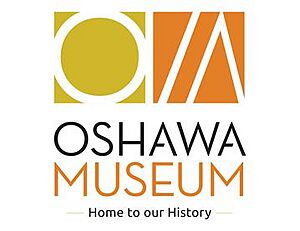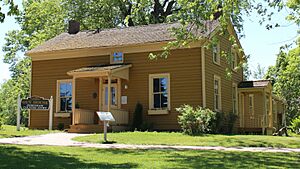Oshawa Museum facts for kids
 |
|
| Lua error in Module:Location_map at line 420: attempt to index field 'wikibase' (a nil value). | |
| Established | May 21, 1960 |
|---|---|
| Location | Oshawa, Ontario, Canada |
| Type | Historical museum |
| Collection size | over 40,000 |
| Visitors | over 10,000 |
The Oshawa Museum is a cool place in Oshawa, Ontario, Canada. It's a history museum that helps us learn about the past. The museum was started by the Oshawa Historical Society.
This museum does two main things. First, it has awesome exhibits for everyone to see. Second, it keeps important old documents and records safe. Every building at the museum is special and protected by the Ontario Heritage Act. The museum helps us remember and celebrate Oshawa's history, from the 1400s all the way to today!
How the Museum Started
The Oshawa Historical Society helps run the Oshawa Museum. This group was formed in 1957. People in Oshawa wanted to save and share the history of their city. The City of Oshawa and the government helped by giving money.
The group was first called "The Oshawa and District Historical Society." In 1959, they became part of the Ontario Historical Society. They officially became a non-profit group in 1965.
Early Days of the Museum
In 1959, the City of Oshawa let the society use three old settler homes. These homes were near the Oshawa harbour. They wanted to turn them into a community museum.
The first part of the museum opened in 1960. It was called the Henry House Museum. This house was built around 1840. It was fixed up to look like a home from the 1870s. It had old furniture and cool historical items.
Growing the Museum
In 1964, another old family home, Robinson House, was in bad shape. It was built around 1856. People worked hard and raised money to fix it up. It was finally restored in 1969.
Many old cottages by the lake were being torn down. So, in 1980, someone suggested saving Guy House. This farmhouse was built around 1845. It had a lot of historical charm. Guy House opened in 1985. This meant the museum now had all three of its main buildings.
In 1988, the society changed its name to "The Oshawa Historical Society." In the 1990s, the museum hosted popular traveling exhibits. One famous exhibit was the Royal Ontario Museum's Discovery of the Titanic. The museum even launched its first website in 1998.
Also in 1998, the museum changed its name again. It went from "Oshawa Sydenham Museum and Community Archives" to "Oshawa Community Museum and Archives." In 2003, there was a fire at Guy House. It damaged some offices and archives. Luckily, less than two percent of the museum's collection was burned. In 2016, the museum changed its name one last time. Now, it's simply known as the 'Oshawa Museum.'
Museum Buildings
The Oshawa Museum has three main buildings. They are Guy House, Henry House, and Robinson House. All of them were built in the early to mid-1800s. These restored buildings help tell the story of Oshawa's local history. All three museum buildings are still on their original spots. The buildings are used for exhibits, special events, and office work.
Guy House (Built around 1845)
Guy House is where the museum's offices are. It's different from Henry House and Robinson House. Guy House is a simple wooden farmhouse. It was built by an early settler named Samuel Phillips. In 1861, he sold it to James Odgers Guy, who lived there for a long time.
Henry House (Built around 1840)
Henry House was built by Thomas Henry around 1840. Thomas Henry was a harbourmaster (someone who manages a harbour), a farmer, and a minister. His father bought the land in 1815. The house was built in a Regency cottage style. It looks like a typical Victorian era home. It has special features like limestone from Kingston, Ontario and a wood-shingled roof. This was the first part of the museum to open. Today, it shows what daily life was like for the Henry family.
Robinson House (Built around 1856)
Robinson House was built in 1856 for the Robinson family. John and Ruth Robinson came to Canada in 1833. They moved to the Oshawa area in 1840. The house stayed in their family until 1965. Then, it was given to the "Oshawa and District Historical Society." Robinson House shows what a typical family home was like back then. It was fixed up and opened to the public in 1969.
The house has a unique Dutch-colonial style. It has a two-level open porch called a veranda. This style was not common in Upper Canada but was seen in New England. Robinson House now has different exhibits. These exhibits show Oshawa's role during the Victorian era and the early 1900s.
Museum Exhibits
Many of the museum's exhibits are found in Robinson House and Henry House.
Permanent Exhibits
A Carrying Place: Oshawa's Indigenous Story
This exhibit is always at the Oshawa Museum. It's on the second floor of Robinson House. It tells the story of Oshawa's Indigenous history. It talks about two archaeological digs in Oshawa. These digs happened at the MacLeod Site (1968–1972) and the Grandview Site (1992).
These digs uncovered the history of the ancestral Wendat people. They lived in the area from 1400 to 1470 CE. During the digs, they found pieces of pottery. They also found proof of settlements and how people moved around. They even found signs of farming methods. Items from these digs are on display. The exhibit also shows the traditional carrying route. It explains what archaeology is. And it highlights the Indigenous community today. This exhibit helps visitors connect with the past. It also celebrates the present Indigenous community. It helps build a spirit of understanding and working together.
Henry House Exhibit
This exhibit shows what life was like for the Henry family. It also gives a good idea of the Victorian era in the 1870s. Some items in the exhibit belonged to the Henry family. Other items belonged to different people who lived in the Oshawa area. You can see a study, where Thomas Henry worked. There's also a parlour for guests, a dining hall, a kitchen, and the main bedroom.
Drive Shed
The Drive Shed was built to celebrate the Oshawa Historical Society's 50th birthday. It opened in 2009. The Drive Shed adds to the Henry House exhibit. It shows old carriages, buggies, and other large historical items. The collection includes two McLaughlin cutters (from around 1900). It also has a Piano Box buggy (from around 1900). Every item in this timber-framed building is connected to Oshawa's industrial past.
Temporary Exhibits
The museum also has temporary exhibits that change often. These exhibits show different parts of local culture and history. They change two or three times a year. This lets the museum show off Oshawa's rich and varied history.
Special Events and Tours
Tours
The museum offers three kinds of tours. You can take a guided tour with a staff member. You can also explore on your own with a self-guided tour. Or you can listen to an audio tour. The museum also offers tours of other places in Oshawa. These include a popular downtown walking tour. They also have tours of the harbour area and Oshawa's Union Cemetery.
Special Events
Many fun events happen at the museum. These include Victorian teas and educational programs for kids. There are also lectures, photography contests, and seasonal events. They also have speaker series where experts talk about history.


